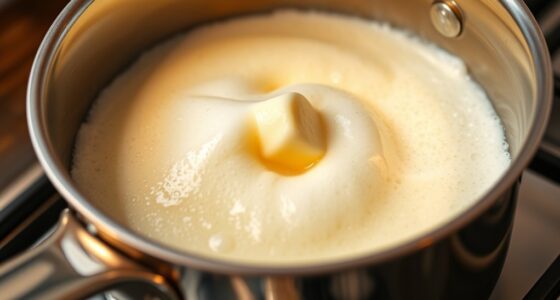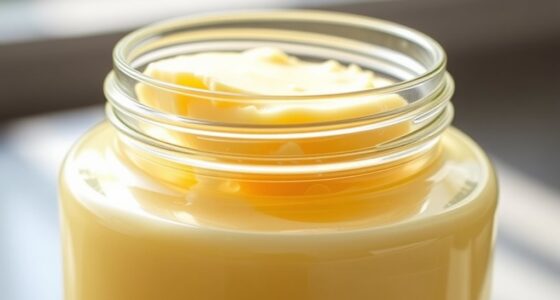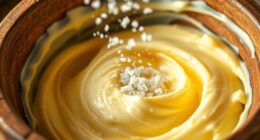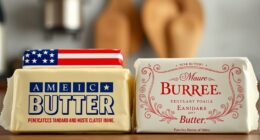High-pressure pasteurization (HPP) uses intense pressure up to 600 MPa to kill harmful microbes in butter without applying heat, preserving its natural flavor and smooth texture. This method extends shelf life, reduces contamination risks, and maintains product quality better than traditional heat pasteurization. It’s a safe, effective option for those seeking minimally processed, high-quality butter. To discover how HPP can benefit your products and guarantee safety without heat, keep exploring the details ahead.
Key Takeaways
- HPP uses up to 600 MPa pressure to inactivate harmful microbes in butter without increasing temperature.
- It preserves natural flavors and textures by avoiding heat-induced changes like softening or cooked tastes.
- HPP extends butter’s shelf life by reducing spoilage organisms and pathogens effectively.
- This non-thermal method enhances safety while maintaining butter’s authentic aroma, consistency, and quality.
- Combining HPP with filtration and advanced sensors offers comprehensive, modern safety and preservation for butter products.
Understanding High-Pressure Pasteurization and Its Principles
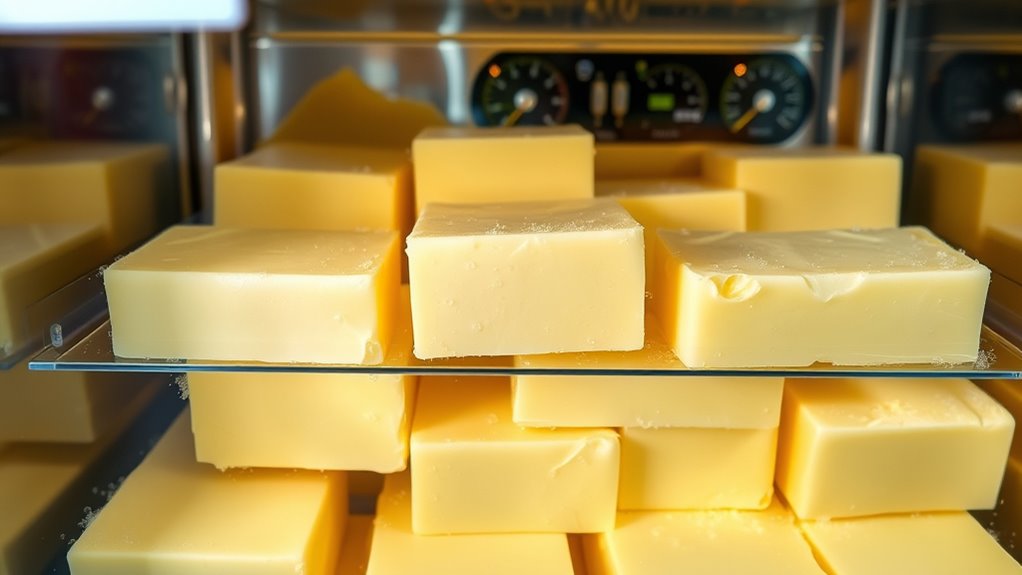
Have you ever wondered how food can be safely preserved without traditional heat treatments? High-pressure pasteurization uses pressure technology to achieve this goal. Unlike the conventional pasteurization process that relies on heat, HPP applies extremely high pressure to food products, disrupting harmful bacteria and pathogens without raising the temperature markedly. This method preserves the food’s nutrients, flavor, and texture better than heat-based methods. During the process, you place the food in a sealed container and subject it to pressures of up to 600 MPa, effectively inactivating microbes. The principles behind high-pressure pasteurization rely on the fact that pressure can alter microbial cell structures, rendering them inactive. High-resolution imaging has been used to study the effects of pressure on microbial cells, providing deeper insight into its effectiveness. This innovative approach offers a safe, efficient alternative to traditional heat treatments, maintaining food quality.
The Advantages of Using HPP for Butter Safety

Using high-pressure pasteurization (HPP) for butter safety offers several significant benefits. First, it helps preserve butter nutrition by inactivating harmful bacteria without heat, ensuring you get the full range of nutrients. Unlike traditional methods, HPP minimizes nutrient loss, making your butter healthier. It also supports dairy farming by enabling producers to deliver safer, high-quality products with fewer additives or preservatives. This process reduces the risk of contamination, which is especially important for consumers seeking clean-label options. Additionally, HPP extends shelf life naturally, reducing food waste and providing greater flexibility in distribution. This technology can also be integrated with other filtration methods for enhanced food safety and quality. Overall, using HPP enhances butter safety while maintaining its natural nutritional value, benefiting both producers and consumers who prioritize quality and health.
How HPP Preserves Butter’s Natural Flavor and Texture
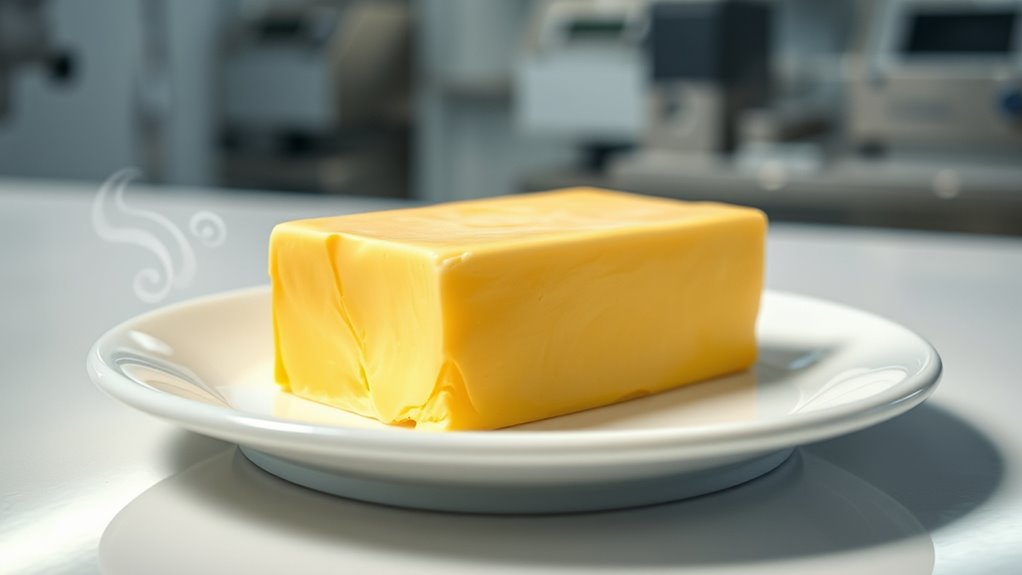
High-pressure pasteurization helps keep butter’s natural flavor intact by gently inactivating bacteria without exposing it to high heat. This process also preserves the butter’s smooth, creamy texture, ensuring it remains fresh and appealing. As a result, you get butter that tastes and feels closer to its original, unprocessed state. Additionally, frozen yogurt products processed with HPP maintain their quality and nutritional benefits, making them a popular choice for health-conscious consumers.
Flavor Preservation Benefits
Because high-pressure pasteurization (HPP) applies intense pressure without heat, it effectively preserves butter’s natural flavor and texture. This method maintains the delicate flavor nuances that heat processing can often diminish or alter. By avoiding heat, HPP helps retain the authentic aroma preservation that defines high-quality butter, ensuring it tastes and smells as fresh as when it was made. You’ll notice the subtle, rich notes remain intact, providing a true reflection of the butter’s original characteristics. This preservation of natural flavors not only enhances your sensory experience but also supports consumers seeking authentic, minimally processed dairy products. Additionally, automation in food processing technologies like HPP are increasingly adopted to ensure consistent quality and safety. With HPP, you get butter that stays true to its fresh, flavorful essence, offering a superior taste that heat-based methods can’t match.
Texture Maintenance Advantages
By preserving butter’s natural flavors through gentle pressure, HPP also maintains its smooth, firm texture without the need for added stabilizers or artificial ingredients. This process guarantees excellent butter consistency and effective texture preservation. You’ll notice that:
- The butter retains its original firmness, preventing it from becoming too soft or grainy.
- Its natural creaminess stays intact, offering a satisfying mouthfeel.
- The overall texture remains stable over time, reducing separation or spoilage issues.
- The gentle pressure involved in HPP helps preserve the aura of freshness, ensuring the butter looks, feels, and performs like fresh, without compromising its quality.
This means you get butter that looks, feels, and performs like fresh, without compromising its quality. HPP’s gentle approach preserves the delicate balance of moisture and fat, ensuring the natural texture remains unaltered. It’s a smarter way to enjoy butter’s true consistency.
Comparing Traditional Heat Pasteurization and High-Pressure Methods

Traditional heat pasteurization has long been the standard method for ensuring food safety, using high temperatures to kill harmful bacteria. While effective, heat can alter butter’s flavor and texture, sometimes causing a cooked or caramelized taste and a softer, less firm texture. High-pressure pasteurization (HPP), on the other hand, uses intense pressure without heat, preserving butter’s natural qualities. With HPP, you retain the fresh butter flavor and its characteristic smooth, firm texture, which heat treatment might diminish. The key difference is that HPP kills microbes while maintaining sensory qualities, making it ideal for consumers seeking fresh-tasting butter with preserved texture. Overall, high-pressure methods provide a gentler alternative that keeps butter’s flavor and texture intact while ensuring safety.
The Impact of HPP on Shelf Life and Microbial Reduction
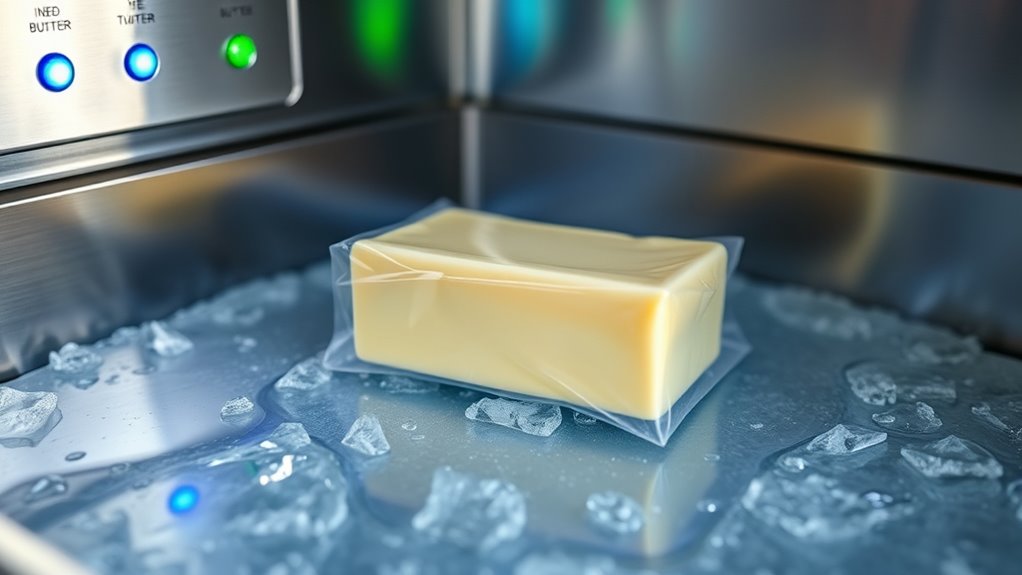
High-pressure pasteurization can considerably extend the shelf life of your products by slowing down spoilage processes. It also enhances microbial safety, reducing the risk of harmful bacteria without compromising quality. Understanding these benefits helps you make informed choices about food preservation methods. Additionally, HPP may support mental well-being by preserving the natural qualities of food, contributing to healthier eating habits.
Extended Shelf Longevity
High-pressure pasteurization considerably extends the shelf life of products by effectively reducing harmful microbes and enzymes that cause spoilage. This process helps maintain butter flavor and enhances shelf stability, making your products last longer without compromising quality. With HPP, you can expect:
- Longer freshness, reducing waste and spoilage costs.
- Improved product consistency, keeping butter flavor intact over time.
- Greater consumer confidence in the product’s safety and quality.
Enhanced Microbial Safety
By applying high-pressure pasteurization, you substantially reduce harmful microbes and enzymes that can cause spoilage, thereby enhancing microbial safety. Unlike traditional ultra pasteurization, HPP achieves microbial inactivation without heat, preserving more of the butter’s natural qualities. This process effectively destroys bacteria, yeasts, and molds, extending shelf life and reducing the risk of contamination. HPP’s ability to target microbes precisely means you can confidently offer safer products with minimal processing. It’s a significant advantage over conventional methods, providing a higher degree of microbial safety while maintaining the butter’s fresh taste and nutritional value. Additionally, understanding the flushing mechanisms involved can help in maintaining optimal storage and handling conditions for dairy products. By incorporating HPP, you assure your butter is not only safer but also retains its quality longer, giving consumers peace of mind and a better overall experience.
Practical Applications and Industry Adoption of HPP in Dairy Production
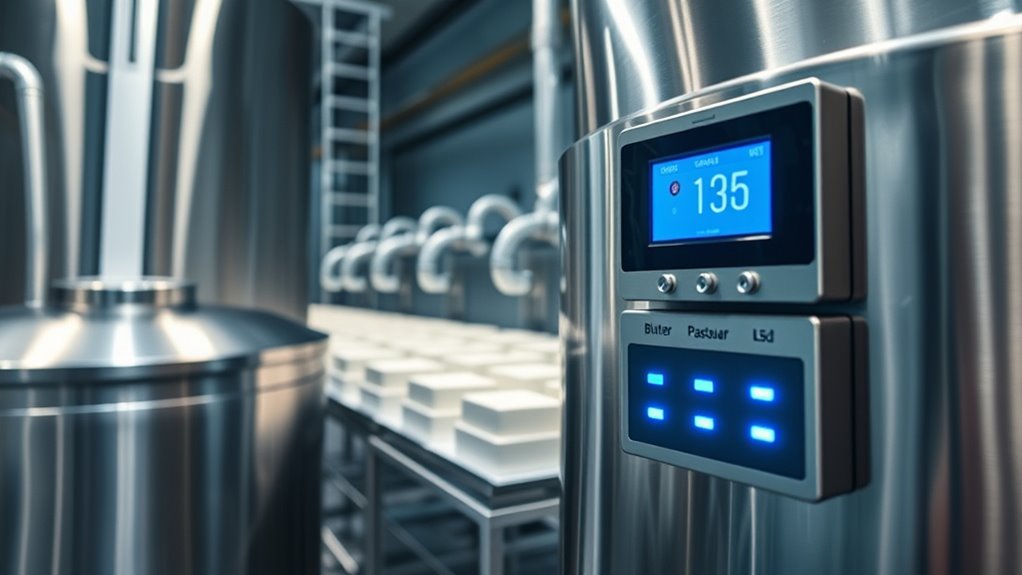
As dairy producers seek safer and fresher products, high-pressure pasteurization (HPP) has gained traction as a practical alternative to traditional heat treatments. This technology aligns well with artisan techniques, allowing producers to maintain natural flavors and textures that consumers prefer. Industry adoption is growing through several approaches: 1. Small-scale dairies use HPP to produce premium, minimally processed products that meet consumer preferences for freshness. 2. Large manufacturers incorporate HPP to extend shelf life while preserving quality, reducing waste and returns. 3. Collaborations with equipment suppliers help streamline integration of HPP into existing production lines, making adoption more feasible. Understanding operating hours can also assist producers in planning logistics and distribution to meet market demand efficiently.
Future Trends and Innovations in Food Safety Technologies
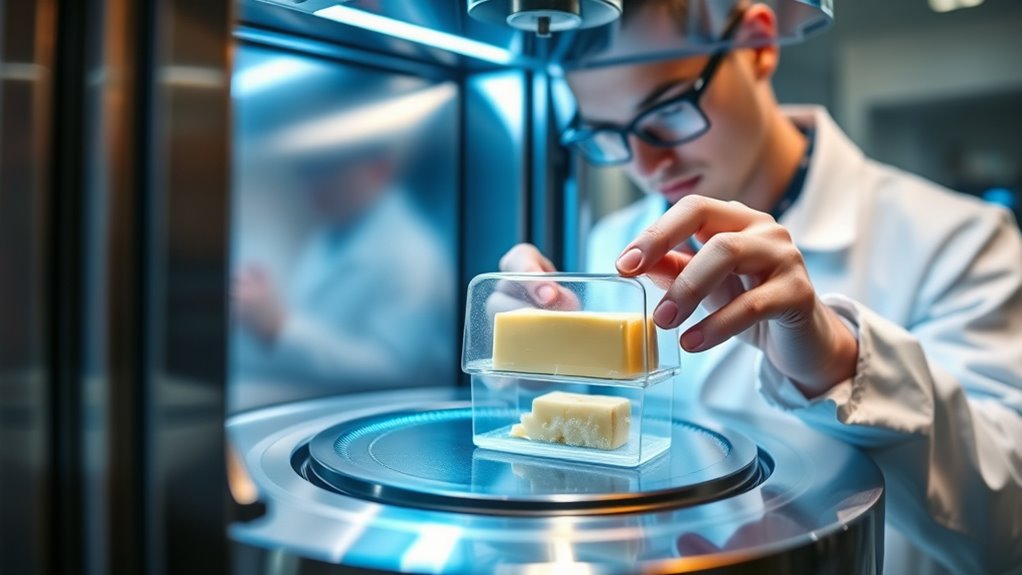
Emerging food safety technologies are rapidly transforming how producers guarantee the safety and quality of their products. Nanotechnology innovations are enabling more effective pathogen detection and improved packaging, extending shelf life without relying on heat. Blockchain traceability is revolutionizing supply chain transparency, allowing you to track products from farm to table in real time. These advancements reduce contamination risks and build consumer trust. The table below highlights key future trends:
| Technology | Benefit | Implementation Example |
|---|---|---|
| Nanotechnology innovations | Enhanced detection and preservation | Smart sensors in packaging |
| Blockchain traceability | Supply chain transparency | Secure, immutable product records |
| AI-powered sensors | Real-time safety monitoring | Automated contamination alerts |
| UV-C light treatments | Non-thermal disinfection | Surface sterilization in processing |
| Edible coatings | Extended shelf life | Natural antimicrobial layers |
Additionally, the integration of advanced sensors can provide continuous monitoring of product conditions, further enhancing safety protocols.
Frequently Asked Questions
Does High-Pressure Pasteurization Affect the Nutritional Content of Butter?
You might wonder if high-pressure pasteurization affects butter’s nutritional integrity. It’s designed to preserve flavor and nutrients by avoiding heat, so it generally sustains the butter’s nutritional content. The process helps ensure safety without compromising essential nutrients like vitamins and healthy fats. Overall, you can enjoy butter with its flavor preserved and nutritional integrity intact, making high-pressure pasteurization an effective method for safe, high-quality butter.
Are There Any Regulatory Approvals for Hpp-Treated Butter Products?
You might wonder about regulatory approvals for HPP-treated butter. Currently, regulatory standards vary by country, and approval processes involve thorough safety evaluations. Agencies like the FDA or EFSA review data to guarantee HPP-treated products meet safety and quality criteria. Although some HPP food applications are approved, specific approval for HPP-treated butter isn’t widespread yet. Keep an eye on regulatory updates, as approvals could expand with ongoing research.
How Does HPP Compare in Cost to Traditional Pasteurization Methods?
When you compare costs, high-pressure pasteurization (HPP) usually has a higher initial equipment investment than traditional methods. However, HPP can reduce ongoing expenses like energy and water use, potentially balancing out costs over time. While traditional pasteurization relies on heat, HPP offers a non-thermal alternative that might be more efficient long-term, especially for preserving product quality and safety without added heat-related costs.
Can HPP Be Applied to Other Dairy Products Besides Butter?
Diving into dairy innovations, you wonder if HPP can handle more than just butter. Absolutely! High-pressure pasteurization is versatile, capable of enhancing food safety across a spectrum of dairy products like milk, cheese, and yogurt. This technique preserves freshness, fights pathogens, and maintains quality without heat. Consequently, you can confidently consider HPP as a safe, sustainable solution to boost dairy product safety and satisfy consumer cravings for clean, wholesome foods.
What Are Consumer Perceptions and Acceptance of Hpp-Treated Butter?
You might wonder how consumers perceive HPP-treated butter. Generally, they trust products that are safe and fresh, but some may worry about unfamiliar processing methods. When it comes to sensory perceptions, HPP-treated butter often retains its natural flavor and texture, which boosts acceptance. If you educate consumers about the safety benefits and minimal sensory changes, their trust can increase, leading to higher acceptance of HPP-treated butter.
Conclusion
High-pressure pasteurization acts like a gentle guardian, safeguarding butter without sacrificing its natural essence. As you explore its benefits, you’ll see it’s a game-changer—preserving flavor, extending shelf life, and keeping microbes at bay without heating. Embrace this innovative technology, and you’ll find that food safety can be both effective and kind to your favorite dairy products. It’s a bright future where quality and safety dance hand in hand, like a well-choreographed performance.


